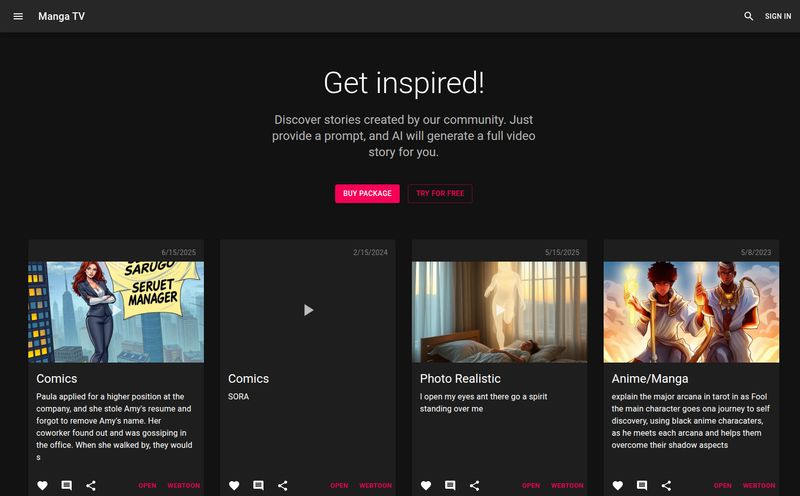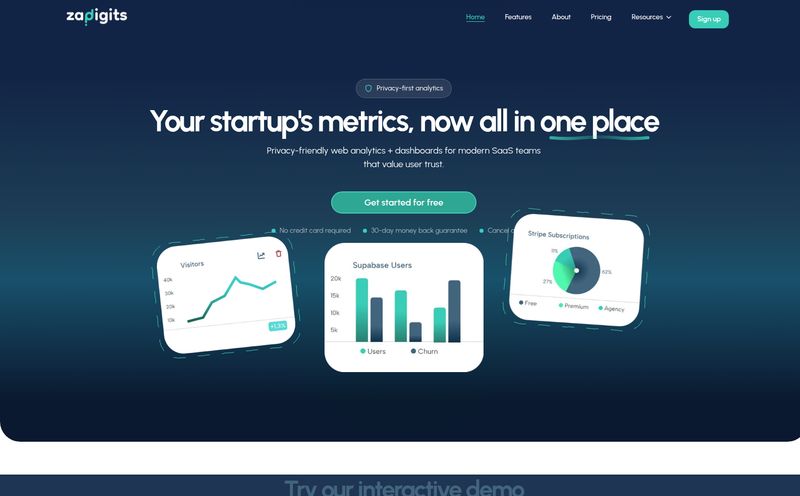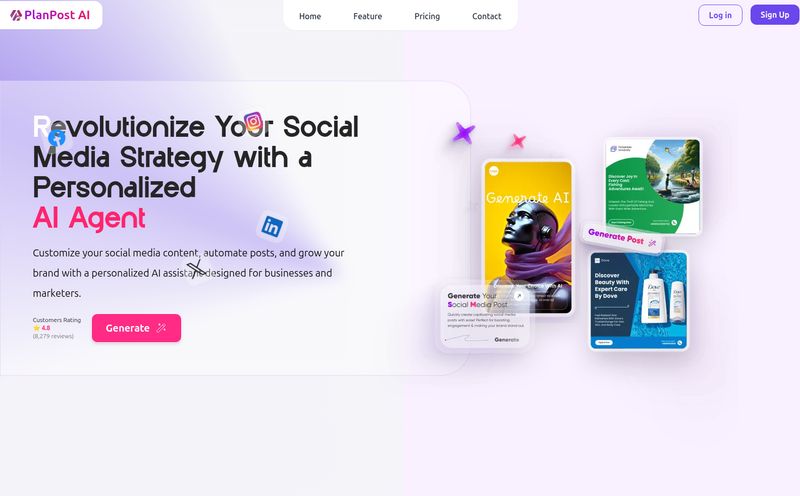Creating video content is a grind. I've spent more hours than I care to admit setting up ring lights, wrestling with lavalier mics, and doing take after take just to flub the one line I’d practiced a dozen times. The whole process can feel like you're trying to assemble IKEA furniture in the dark. You know the end result will be great, but getting there is... a journey.
So, when a tool pops up promising to let me create a video of myself just by typing out a script, my ears perk up. I’m talking about SpiritMe, one of the latest players in the burgeoning AI text-to-video space. It claims you can create a lifelike digital avatar in about five minutes and then have it churn out videos on demand. Is it another piece of AI hype, or is it the content creation assistant I've been dreaming of? Let's get into it.

Visit SpiritMe
So, What is SpiritMe, Really?
At its core, SpiritMe is an AI platform designed to take the human element out of video production... while, paradoxically, keeping the human element in. You create a digital version of yourself—an avatar—and that avatar becomes your on-screen talent. You feed it a script (just type the text), and the AI generates a video of your avatar speaking those words. It's not just a static image with a moving mouth, either. The platform is built to replicate your face, your voice, and your emotions to create a surprisingly realistic result.
Think about it. No more re-shoots because you stumbled over a word. No more worrying about the lighting being perfect or that dog barking in the background. It's like having a video production studio in your pocket, minus the grumpy sound guy. For content creators, marketers, or even corporate trainers, the potential here is pretty massive.
How Does This Sorcery Actually Work?
The magic starts with your phone. And not just any phone—you need an iPhone for the initial setup. The creation process is supposedly a breezy five minutes. You follow a few on-screen instructions, recording your face and voice, and the AI gets to work building your digital doppelgänger. I've seen a few tools do this, but the five-minute claim is bold.
Once your avatar is ready, it lives in the platform, waiting for your commands. You log in, type out your script for a social media short, a product update, or a course module, and hit generate. A few minutes later, you have a ready-to-post video. Your avatar is available 24/7, never needs a coffee break, and will never complain about the script. A true professional.
The Standout Features I'm Watching
Your Digital Twin in Minutes
The biggest hook is obviously the AI avatar creation. The idea of digitizing yourself for content isn't brand new—companies like Synthesia have been in this space for a while. But SpiritMe's focus on a hyper-fast, mobile-first creation process feels different. It lowers the barrier to entry significantly. You don't need a green screen or a fancy studio session; you just need your phone and a few minutes. If it works as advertised, its just a massive time-saver.
The Dynamic Facial Expressions Engine is a Game-Changer
Here’s where things get really interesting. The biggest problem with early AI avatars was the uncanny valley effect. They looked... robotic. Lifeless. SpiritMe boasts a “Dynamic Facial Expressions Engine,” which is a fancy way of saying it tries to make your avatar emote realistically. It analyzes the text for emotional cues and translates them into corresponding smiles, frowns, or looks of surprise.
This is crucial. Communication is so much more than words. It's the subtle smirk, the raised eyebrow, the genuine smile. If SpiritMe can nail this, it moves beyond being a simple text-to-speech tool with a picture and becomes a genuine communication platform. I’m cautiously optimistic here, because getting emotion right is the holy grail of this technology.
Who Is This Tool Actually Built For?
While any creator could find a use for this, I see a few groups that could really benefit. Marketers could quickly generate personalized video messages for outreach campaigns. Educators and online course creators could update their lessons without having to re-record entire modules. Corporate teams could create consistent and professional internal training videos without booking a studio. Even social media managers juggling multiple accounts could use it to maintain a consistent “face” for a brand, creating daily tips or updates with incredible efficiency.
The Good, The Bad, and The... iPhone?
Alright, no tool is perfect. On the one hand, the ease of use is a massive win. The thought of ditching my camera, lights, and mic for a simple app is incredibly appealing. Plus, having a virtual actor who never gets tired or asks for a raise? That's a dream for anyone trying to scale their content output. It solves a real-world production bottleneck.
However, I have to be honest, the iPhone-only requirement for avatar creation is a bit of a head-scratcher. It immediately alienates a huge chunk of the market. I'm guessing it has something to do with the quality of the iPhone's TrueDepth camera for facial mapping, but it's still a significant hurdle for Android users. Also, the specter of a subscription model looms. The provided info suggests advanced features might be behind a paywall, which is standard for SaaS, but something to be aware of. You might get a taste for free, but the full power will likely cost you.
Let's Talk About Pricing
Speaking of cost... this is where the information gets a little fuzzy. As of my research, SpiritMe hasn't published a clear pricing page. This isn't uncommon for new B2B-focused AI tools. Often, it means they're either still figuring out their pricing tiers or they're focusing on enterprise clients with custom plans. You'll likely have to sign up or contact their sales team to get the specifics. My advice? Assume there will be different tiers based on the number of video minutes you can generate per month.
My Final Take: Is SpiritMe Worth Your Time?
I think so. Yes, with a few caveats. SpiritMe feels like its on the right track. It’s tackling one of the biggest pain points in the digital economy: fast, affordable, scalable video creation. The focus on realistic emotional expression could be its secret sauce.
If you're an iPhone user who creates a lot of talking-head style video content, I'd say it's absolutely worth exploring. It could genuinely change your workflow and free up dozens of hours a month. For Android users, we'll have to wait and see. For now, it's a fascinating glimpse into a future where content creation is more about ideas and less about logistics. And I, for one, am here for that.
Frequently Asked Questions about SpiritMe
How long does it take to create a SpiritMe avatar?
According to SpiritMe, the entire process of creating your digital avatar takes about 5 minutes using their mobile application on an iPhone.
Do I need special equipment to use SpiritMe?
For the initial avatar creation, you need an iPhone. The company states this is to ensure high-quality facial capture. After your avatar is created, you can generate videos from text on their web platform without any special hardware.
Can my SpiritMe avatar actually show emotions?
Yes, this is one of its main features. SpiritMe uses a 'Dynamic Facial Expressions Engine' that analyzes your script's text to generate realistic emotional expressions, making the final video appear more natural and engaging.
What happens to my data and avatar?
When you create an avatar, you are providing your biometric data (face and voice). As with any AI service, it's super important to review their Privacy Policy and Terms of Service to understand how your data is stored, used, and protected. I always recommend doing this before uploading personal information.
Is SpiritMe free?
There may be a free trial or a limited free tier to test the platform. However, the information available suggests that for full access to all features and for generating a significant amount of video content, a paid subscription will likely be required.
Final Thoughts
The world of AI tools is moving at a breakneck pace, and it’s hard to keep up. But platforms like SpiritMe aren’t just novelties; they’re practical solutions to real problems. While it’s not perfect, the promise of instant, emotional, and scalable video is too compelling to ignore. It’s a tool that acknowledges our desire to be seen and heard, but respects our most valuable asset: time. And that's a pretty powerful combination.
Reference and Sources
- SpiritMe Official Website
- Wyzowl - Video Marketing Statistics for 2024 (For context on the importance of video)



